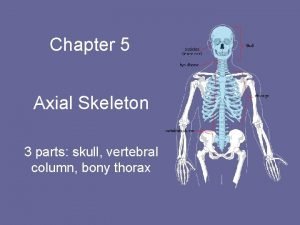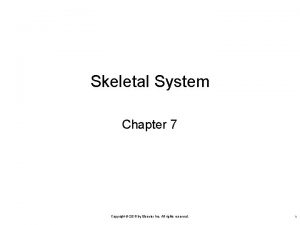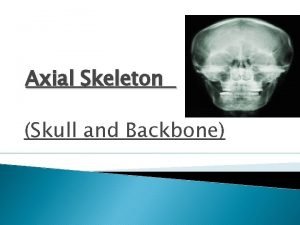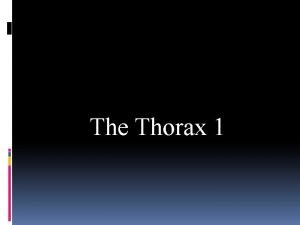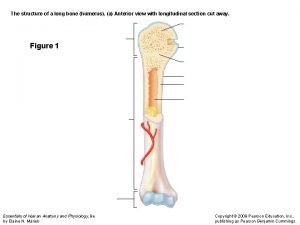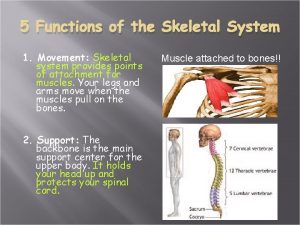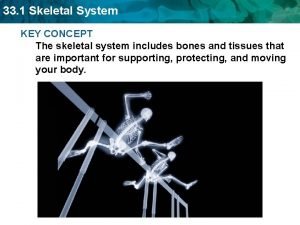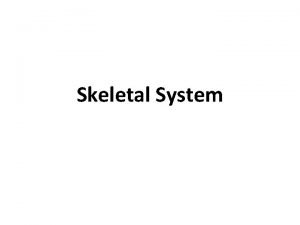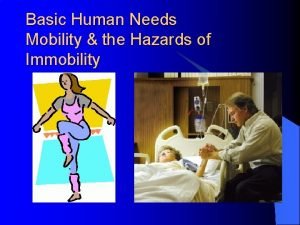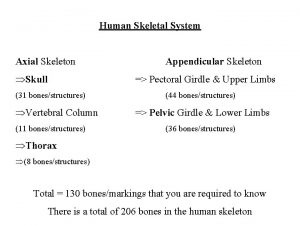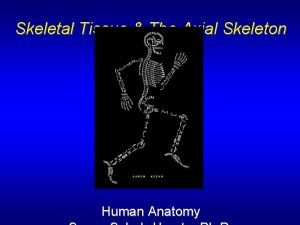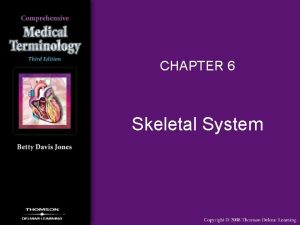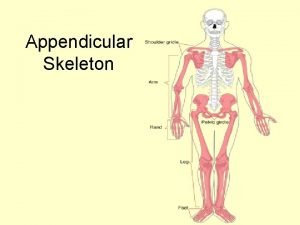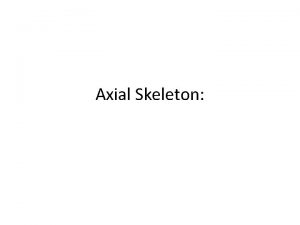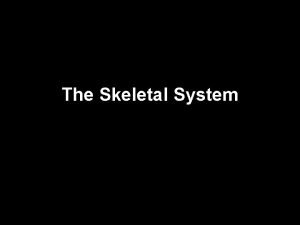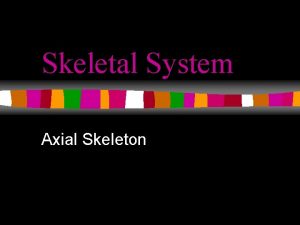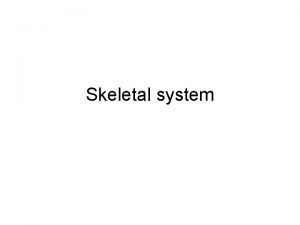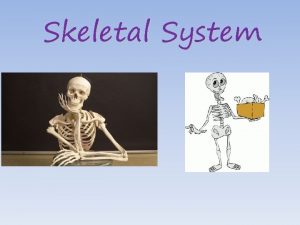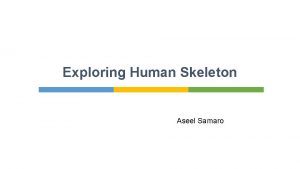THE HUMAN SKELETON THE HUMAN SKELETON The Skeletal












- Slides: 12

THE HUMAN SKELETON

THE HUMAN SKELETON Ø Ø Ø Ø The Skeletal System is the frame work of the body and provides support and protection. The human skeletal system is made up of 206 bones which rely on bone marrow, tendons and ligaments to function. Bones are made up of two types of tissue: Compact or dense tissue and spongy tissue There are 4 types of bones: Long bones (like those in the arms and legs) Short bones (like those found in the ankles and wrists) Flat bones (like ribs and those in the skull) Irregular bones (like the vertebrae in the spine)

THE HUMAN SKELETON Ø All bones are filled with a spongy material called Bone Marrow. Bone marrow is either red or yellow. Ø Red marrow is primarily found in flat bones. Ø Yellow bone marrow is primarily made of fatty bone cells and is found in long bones. Ø Bone is a tough and rigid form of connective tissue. It is the weight bearing organ of human body and it is responsible for almost all strength of human skeleton. Ø Cartilage: Cartilage is also a form of connective tissue but is not as tough and rigid as bone. The main difference in the cartilage and bone is the mineralization factor. Bones are highly mineralized with calcium salts while cartilages are not. Ø Joints are important components of human skeleton because they make the human skeleton mobile.

THE HUMAN SKELETON Ø Parts of the Human Skeleton: Ø Skull: Skull is that part of human skeleton that forms the bony framework of the head. It consists of 22 different bones that are divided into two groups: bones of cranium and bones of face. Ø Vertebral Column: It is a flexible column of vertebrae, connecting the trunk of human body to the skull and appendages. It is composed of 33 vertebrae which are divided into 5 regions: Cervical, Thoracic, Lumbar, Sacral, and Coccygeal.

THE HUMAN SKELETON Ø Rib Cage: It is a bony cage enclosing vital human organs formed by the sternum and ribs. There are 12 pairs of ribs that are divided into three groups: True ribs, False ribs, and Floating ribs. Ø Axial Skeleton Appendicular Skeleton: It is the skeleton of appendages of human body. It consists of Shoulder girdle, Skeleton of upper limb, Pelvic girdle and Skeleton of lower limb. Ø Shoulder Girdle: It attaches the upper limb to body trunk and is formed by two bones: clavicle and scapula. Clavicle is a modified long bone and is subcutaneous throughout its position. It is also known as the beauty bone.

THE HUMAN SKELETON Ø Skeleton of Upper limb: The skeleton of each upper limb consists of 30 bones. These bones are: Humerus, Ulna, Radius, Carpals, Metacarpals, Phalanges. Ø Pelvic Girdle: There are two pelvic girdles (one for each lower limb) but unlike the pectoral girdles, they are jointed with each other at symphysis pubis. Each pelvic girdle is a single bone in adults and is made up of three components: Ileum, Ischium and Pubis. Ø Skeleton of Lower limb: The skeleton of each lower limb consists of 30 bones. These bones are; Femur, Tibia, Patella, Tarsals, Metatarsals, Phalanges. Click on the name of any bone for more details. Appendicular Skeleton Functions of human skeleton: Ø Human skeleton performs some important functions that are necessary for survival of human beings. Ø (See next slide)

THE HUMAN SKELETON Ø 1. STRENGTH, SUPPORT AND SHAPE: It gives strength, support and shape to the body. Without a hard and rigid skeletal system, human body cannot stand upright, and it will become just a bag of soft tissues without any proper shape Ø 2. PROTECTION OF DELICATE ORGANS: In areas like the rib cage and skull, the skeleton protects inner soft but vital organs like heart and brain from external shocks. Any damage to these organs can prove fatal, therefore protective function of skeleton is very important. Ø 3. LEVERAGE FOR MOVEMENTS: Bones of the human skeleton in all parts of body provide attachment to the muscles. These muscles provide motor power for producing movements of body parts. In these movements the parts of skeleton acts like levers of different types thus producing movements according to the needs of the human body.

THE HUMAN SKELETON Ø 4. PRODUCTION OF BLOOD CELLS: Bones like the sternum, and heads of tibia have hemopoeitic activity in the red marrow (blood cells production). These are the sites of production of new blood cells – red, white and platelets. Stromal activity is responsible for the production of fat, cartilage, and bone. Ø Finally, the skeleton grows throughout childhood and provides a framework for the rest of the body to grow along with it. Ø Skeletal System Anatomy: The skeletal system in an adult body is made up of 206 individual bones. These bones are arranged into two major divisions: the axial skeleton and the appendicular skeleton. The axial skeleton runs along the body’s midline axis and is made up of 80 bones in the following regions: Ø Ø Ø Ø Skull Hyoid Auditory ossicles Ribs Sternum Vertebral Column Upper limbs Lower limbs Pelvic Girdle Pectoral (shoulder) Girdle Cervical (neck)- 7 vertebrae Thoraic (chest) – 12 vertebrae Lumbar (lower back)- 5 vertebrae Sacrum- 1 vertebra Coccyx (tailbone)- 1 vertebra

MICROSCOPIC STRUCTURE OF BONES Ø The skeleton makes up about 30 -40% of an adult’s body mass. The skeleton’s mass is made up of nonliving bone matrix and many tiny bone cells. Ø Roughly half of the bone matrix’s mass is water, while the other half is collagen protein and solid crystals of calcium carbonate and calcium phosphate. Ø Living bone cells are found on the edges of bones and in small cavities inside of the bone matrix. Although these cells make up very little of the total bone mass, they have several very important roles in the functions of the skeletal system.

THE HUMAN SKELETON Ø Ø The bone cells allow bones to: Grow and develop Be repaired following an injury or daily wear Be broken down to release their stored materials Ø Types of Bones Ø All of the bones of the body can be broken down into five types: long, short, flat, irregular, and sesamoid. Ø Long bones are longer than they are wide and are the major bones of the limbs. Long bones grow more than the other classes of bone throughout childhood and so are responsible for the bulk of our height as adults. A hollow medullary cavity is found in the center of long bones and serves as a storage area for bone marrow. Examples of long bones include the femur, tibia, fibula, metatarsals, and phalanges.

THE HUMAN SKELETON Ø Short bones are about as long as they are wide and are often cubed or round in shape. The carpal bones of the wrist and the tarsal bones of the foot are examples of short bones. Ø Flat bones vary greatly in size and shape, but have the common feature of being very thin in one direction. Because they are thin, flat bones do not have a medullary cavity like the long bones. The frontal, parietal, and occipital bones of the cranium—along with the ribs and hip bones—are all examples of flat bones. Ø The sesamoid bones are formed after birth inside of tendons that run across joints. Sesamoid bones grow to protect the tendon from stresses and strains at the joint and can help to give a mechanical advantage to muscles pulling on the tendon. The patella and the pisiform bone of the carpals are the only sesamoid bones that are counted as part of the 206 bones of the body.

 Chapter 7 4 skeletal system
Chapter 7 4 skeletal system Chapter 5 the skeletal system figure 5-13
Chapter 5 the skeletal system figure 5-13 Axial skeleton
Axial skeleton Chapter 7:4 skeletal system label the skeleton
Chapter 7:4 skeletal system label the skeleton Appendicular vs axial skeleton
Appendicular vs axial skeleton Axial skeleton vs appendicular skeleton
Axial skeleton vs appendicular skeleton Axial vs appendicular skeletal system
Axial vs appendicular skeletal system Structure of a long bone
Structure of a long bone 5 functions of the skeletal system
5 functions of the skeletal system Chapter 14 the skeletal muscular and nervous systems
Chapter 14 the skeletal muscular and nervous systems Skeletal
Skeletal Parts of a long bone
Parts of a long bone Hazards of immobility
Hazards of immobility


